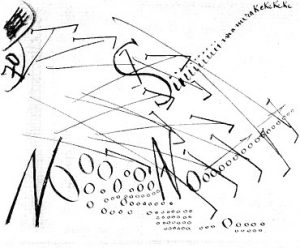There was a girl who came from a small town by the sea, and what made her more happy than anything else was to watch waves. She would walk down to the water’s edge, passing the little white houses that speckled the foggy shoreline, until she was right above the water on a rocky ledge or a beach of little stones, and there she would stay for hours, alone, watching the waves rise and fall, crest and crash. The tide would come and go, the fog would roll in and roll out, and still the girl would gaze at the sea.
The other people in the town did not understand why the girl did this. They did not enjoy sitting and staring all day at the water. Instead they built boats, and fished, or they cut down great towering pines, to build their houses, while others cultivated little green gardens and pastures of sheep. The people in the town worked on the land and in the water to make a living, to make food and shelter and things to sell to one another and this was what their forebearers had done, too. But the girl who watched waves did none of this, she did nothing at all, so far as they were concerned, and so to them she seemed quite useless, quite strange.
Is it strange to stare for hours at the surface of the sea? Maybe. Is it less strange to haul fish or fell trees or hammer nails or kill sheep? Maybe.
In any case it so happened that a doctor arrived in the town. Doctors were considered very wise. They trained for many, many years, and became skilled at poking and prodding the living, at peering inside noses and ears and mouths and eyes and saying “this is what is wrong with you” and if you payed them they would tell you how to get better, how to change. Sometimes the doctors gave good advice, and sometimes they didn’t, but in the end very few people were willing to forgo paying for such advice, once they discovered they were sick. Everyone listens to the stories a doctor tells.
So the people in the town decided that they would ask the doctor to look at the girl who watched waves, and talk to her. She would not listen to any of them, but perhaps she would listen to the doctor. If he told her to stop watching waves and come work, then likely she would do just that. The doctor found the girl sitting by the seashore and he began to examine her. He checked her pulse and her temperature, he checked her reflexes and vision, he checked everything. He also talked to her, asking her many questions. When his examination was over the doctor told the girl a story about how she was healthy in her body but sick in her mind. Initially the girl ignored the doctor, and continued to stare out at the sea, untroubled by his words. But the doctor’s diagnosis had planted a seed of doubt. Before he went away the doctor told the girl that it was not healthy to sit apart from the townsfolk, to shun their company and way of life in favour of the grey churning water. Such behaviour was called “antisocial” and “melancholy” and these were characteristics of someone who was ill.
These words began to churn in the girl’s mind, just like the grey water. The slosh of waves upon rock seemed to say “sick! sick!” again, and again, while the wind that came reaching from the sea howled sadly, whistling through the ancient pines with a sound like “ill!” For some reason the girl could not sit and watch the water in peace any longer. The doctor’s story about sickness was all around her, in the very salt-air she breathed.
The girl knew, as the townsfolk knew, that it really would be madness to ignore a doctor and his diagnosis. So she got up and left the shore and returned to the foggy little town to work. She tried cutting wood, she tried herding sheep. She worked in the gardens and in the houses. But she was no good at any of it. She was constantly staring out to sea, from a distance, longing to be closer, close enough to watch the waves. But she could not watch waves anymore because the doctor’s words had changed everything. She was ill, now, and when she looked at the sea, she no longer saw waves she saw her illness.
One day the girl who no longer watched waves went out to sea with the fishing boats. She had no skill for other types of work. She tried her hand at hauling nets full of fish and crab and other sea creatures. However, though she had been used to staring at the surface of the sea she was unaccustomed to standing atop it. The waves rocked the boats and the the girl could feel them beneath her. She smiled, to be reminded of the presence of her previous waves, but as she paused she lost balance and slipped. She could not swim, so she was washed away and drowned.
The people in the town by the sea would tell this tale and say, in the end, that the doctor simply told his story too late. If the girl had never been allowed to watch the waves at all, perhaps she would have learned to work in the woods or the pastures or water, like the other townsfolk. But as it was her illness festered, she was too sick to be saved, they said. No one thought to suggest that the doctor should have never diagnosed her at all. Madness.

